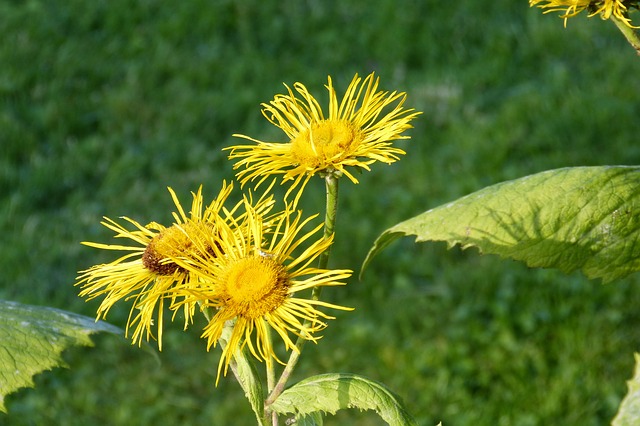 |  |  |  |  |
 |  |  |
Elecampane is a perennial plant, up to 150 cm tall. The rhizome is thick, up to 5 cm, fleshy and often with several tops. The rhizome also forms lateral roots. The stem is erect, hairy, grooved, branched at the top. The leaves are large, arranged alternately, elongated elliptic with unevenly toothed edges.
Flower baskets 3-7 cm large on thick pedicels, located at the top of the stem. Flowers golden yellow. Fruits - four-sided seed. The plant blooms in July-August, the fruits ripen in August-September.
Rhizomes and roots of
Elecampane
are used for medicinal purposes. Rhizomes and roots are dug in autumn, less often in early spring. The collected rhizomes and roots are cleaned from the ground, rinsed in running water, the surface part is separated with a knife, cut into pieces and twisted a little. Rhizomes and roots are dried on sieves or in forced dryers at a temperature of 35-50C.
The plant is rarely found in the wild in Latvia, but there are cases when it sows itself from a garden. More often, this plant is cultivated as a medicinal plant.
The rhizome and roots of
Elecampane
contain essential oil (<4%). It smells a bit like fragrant violet. They also contain inulin (<40%), inulinin, pseudoinulin, mucilage, organic acids (acetic acid, benzoic acid), vitamin E, saponins, gums, resins, a small amount of alkaloids, micro and macro elements.
Medicinal significance
Elecampane
has many valuable properties. A decoction of rhizomes and roots works as an expectorant. The plant also acts as an anti-inflammatory, antimicrobial, choleretic and diuretic agent. Aloe vera stops bleeding and helps heal wounds.
Preparations containing
Elecampane
reduce the secretory function of the bronchi, promoting expectoration processes. The saponin and essential oil present in the plant increase the production of mucus in the bronchi, thus increasing the secretion of mucus. When using extracts of
Elecampane
oil, the process of lipid peroxidation decreases and the activity of antioxidant enzymes increases, which contributes to the reduction of inflammatory processes, changes in the chemical composition of sputum, accordingly, they become more liquid and their evacuation occurs faster.
The rhizome and roots have hypoglycemic activity, which is justified by the presence of inulin. It has been clinically established that the plant oil extract normalizes the blood glucose content in type 2 diabetics. In addition, symptoms such as dry mouth, thirst and frequent urination disappear in patients.
When using
Elecampane
, intestinal peristalsis and secretory activity decrease, but bile production increases and it is pushed to the duodenum. Observing this feature and taking into account the anti-inflammatory and antiseptic properties of the plant, it becomes an excellent remedy for the digestive organs.
When using the preparations of this plant, prepared on the base of the essential oil containing it, in the treatment of gastric and duodenal ulcers, pain disappears, appetite improves, body weight increases, especially with a reduced diet. As a result, ulcers heal significantly faster or decrease in size.
The essential oil strengthens the blood supply in the walls of the stomach, increasing the regeneration processes, stimulating the production of buffer substances.
The anti-inflammatory properties of
Elecampane
are also provided by the essential oil present in the plant. In addition, it also acts as an antiseptic and strongly against helminths, as well as a small amount of fungicidal activity. These properties can be used to develop agents against mycotic eczema.
It's only good to know that the essential oil of Elecampane is insoluble in water, therefore it is recommended to prepare extracts in alcohol or wine.
Phytopreparations of
Elecampane
have a destructive effect on red and interdigital trichophytons, less active, but also active on golden staphylococcus, shigella, salmonella, escherichia, cholera vibrio and inactive on tuberculosis microbacterium.
In folk medicine, the plant is widely used, it is used to treat colds and lung diseases, as well as diseases of the digestive tract - diarrhea, gastroenteritis, gastritis, reduced gastric juice content.
Elecampane
stimulates the appetite, improves digestion, helps women with problems (painful periods, absence of them, uterine prolapse), and is also used for liver and bladder diseases, diabetes, migraine, epilepsy, tachycardia, kidney stone disease, hemorrhoids and used as an antihelminthic agent. The plant is also used to treat kidney frostbite and inflammation.
A decoction or infusion of Helenium alantis flowers is used for hangovers. The plant helps to regain clarity faster if it is taken before and after drinking alcohol. In mixtures with other herbs, helenium alantis is used to treat impotence, prostatitis, prostate adenoma, enhance erection, and prevent male infertility.
